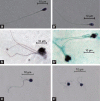Mutations of the aurora kinase C gene causing macrozoospermia are the most frequent genetic cause of male infertility in Algerian men
- PMID: 25219909
- PMCID: PMC4291881
- DOI: 10.4103/1008-682X.136441
Mutations of the aurora kinase C gene causing macrozoospermia are the most frequent genetic cause of male infertility in Algerian men
Abstract
Klinefelter syndrome and Y-chromosomal microdeletion analyses were once the only two genetic tests offered to infertile men. Analyses of aurora kinase C (AURKC) and DPY19L2 are now recommended for patients presenting macrozoospermia and globozoospermia, respectively, two rare forms of teratozoospermia particularly frequent among North African men. We carried out genetic analyses on Algerian patients, to evaluate the prevalence of these syndromes in this population and to compare it with the expected frequency of Klinefelter syndrome and Y-microdeletions. We carried out a retrospective study on 599 consecutive patients consulting for couple infertility at the assisted reproduction unit of the Ibn Rochd Clinique, Constantine, Algeria. Abnormal sperm parameters were observed in 404 men. Fourteen and seven men had typical macrozoospermia and globozoospermia profiles, respectively. Molecular diagnosis was carried out for these patients, for the AURKC and DPY19L2 genes. Eleven men with macrozoospermia had a homozygous AURKC mutation (79%), corresponding to 2.7% of all patients with abnormal spermograms. All the men with globozoospermia studied (n = 5), corresponding to 1.2% of all infertile men, presented a homozygous DPY19L2 deletion. By comparison, we would expect 1.6% of the patients in this cohort to have Klinefelter syndrome and 0.23% to have Y-microdeletion. Our findings thus indicate that AURKC mutations are more frequent than Klinefelter syndrome and constitute the leading genetic cause of infertility in North African men. Furthermore, we estimate that AURKC and DPY19L2 molecular defects are 10 and 5 times more frequent, respectively, than Y-microdeletions.
Figures



References
-
- Boivin J, Bunting L, Collins JA, Nygren KG. International estimates of infertility prevalence and treatment-seeking: potential need and demand for infertility medical care. Hum Reprod. 2007;22:1506–12. - PubMed
-
- Schlosser J, Nakib I, Carré-Pigeon F, Staerman F. Male infertility: definition and pathophysiology. Ann Urol (Paris) 2007;41:127–33. - PubMed
-
- Tiepolo L, Zuffardi O. Localization of factors controlling spermatogenesis in the nonfluorescent portion of the human Y chromosome long arm. Hum Genet. 1976;34:119–24. - PubMed
-
- Dieterich K, Soto Rifo R, Faure AK, Hennebicq S, Ben Amar B, et al. Homozygous mutation of AURKC yields large-headed polyploid spermatozoa and causes male infertility. Nat Genet. 2007;39:661–5. - PubMed
Publication types
MeSH terms
Substances
LinkOut - more resources
Full Text Sources
Medical

